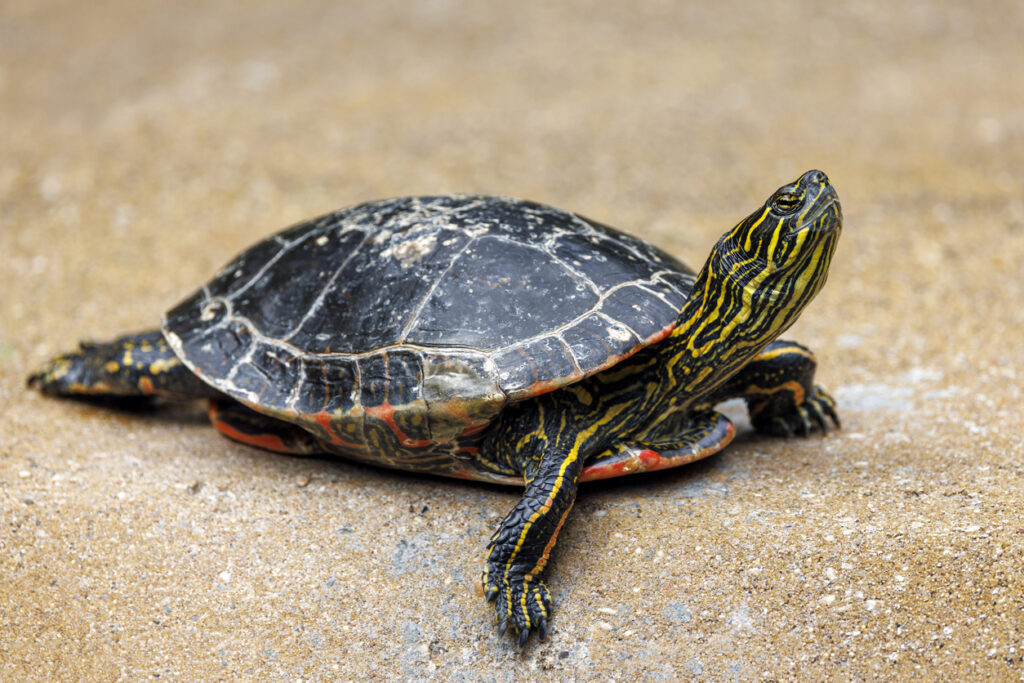Bristol Aquarium is home to a whole host of fascinating creatures, and despite being an aquarium, some of those creatures spend quite a bit of time on land.
One type of creature that spends time on land and in water is the terrapin. These nifty little turtles are not only incredibly cute, but they’re also wonderfully interesting creatures to see and learn about.
Let’s slide right into the facts!
What is a terrapin?
A terrapin is a small type of turtle that lives in almost every corner of the world. They are part of the Testudines order, meaning that they share the same characteristics as other animals in this order such as turtles and tortoises.
Unlike turtles and tortoises, the term terrapin is entirely colloquial and doesn’t have any meaning scientifically. It’s just a word for tortoises that also like to be in water.
Terrapins are sometimes called sliders because they slide into the water to avoid predators from snapping them up.
How big are terrapins?
Terrapins are essentially just a small species of turtle, so you shouldn’t expect them to grow very big. Common species such as the diamondback terrapin (Malaclemys terrapin), grow up to about 9 inches in length, with males typically only growing to about 5 inches.

What species of terrapin are there?
There are 14 species of turtle that are considered terrapins, despite the word terrapin not holding much weight scientifically. These species include:
Diamondback terrapin (Malaclemys terrapin)
The diamondback terrapin is a small reptile with a brown or grey shell. They’re recognisable for their diamond-shaped markings on their shell, along with unique black markings on their legs and head.
Indian black turtle (Melanochelys trijuga)
This medium-sized turtle is native to South Asia and lives in fresh water where its angular shell and dark colours allow it to easily camouflage itself while it hunts for food.
European pond terrapin (Emys orbicularis)
The European pond terrapin looks quite similar to the Indian black turtle, but they live throughout Europe as opposed to Asia. Known for their particularly long life, they’re a common pet among reptile enthusiasts.
Painted terrapin (Batagur borneoensis)
This is a relatively large terrapin with a domed shell. During the mating season, they exhibit bright colours designed to attract a mate, giving them the name the painted terrapin. These reptiles can be found in mangrove swamps and river estuaries across Southeast Asia.
Where do terrapins live?
Terrapins in the modern world, can be found almost everywhere. These cold-blooded animals favour warm climates where they can bask in the sun, and so aren’t usually found in cooler climates like the UK.
Scientists believe that terrapins originate from the US, specifically in land surrounding the Gulf of Mexico. You’re unlikely to find a terrapin in the salty water of the Gulf of Mexico though, with terrapins preferring fresh or brackish water.
Estuaries, wetlands, marshes, mangrove swamps, lagoons, and river mouths where freshwater and saltwater mingle are typically where they make their homes.
What do terrapins eat?
Terrapins are omnivores, like humans, meaning they eat both animal and plant matter. In the wild, they typically feed on insects, small fish and crustaceans as well as leafy greens and aquatic plants.
When in captivity, special care must be taken to ensure that approximately 80% of their diet is made up of animal matter, with the remaining 20% being plant matter to avoid issues that can arise from nutritional deficiencies.
Understanding the types of terrapin at Bristol Aquarium

At Bristol Aquarium, we’re blessed to have three types of terrapin, each unique and brilliant in their own little ways. Let’s explore the characteristics of these species so you can spot them during your next visit.
Red-eared slider (Trachemys scripta elegans)
The red-eared slider is impossible to miss due to its distinctive red marking on its head. These terrapins are usually found in the United States but you can find them in our Amazing Amazon exhibit.
Yellow-bellied slider (Trachemys scripta scripta)
The yellow-bellied slider is unmistakable thanks to its beautifully coloured black and yellow shell. Another United States native, the yellow-bellied slider can live up to 40 years in captivity!
Mississippi map turtle (Graptemys pseudogeographica kohni)
Named after the incredibly famous river, the Mississippi map turtle is native to the United States and resembles a topographical map thanks to its distinct black and white markings across its body.
Geoffrey’s side-necked turtle (Phrynops geoffroanus)
Living with our terrapins in our large Amazing Amazon tank, you will also find a Geoffrey’s side-necked turtle (Phrynops geoffroanus). The species hails from South America although this one came to Bristol from Weston-Super-Mare aquarium when it sadly closed its doors. It’s for this reason that she’s nicknamed Weston!
That concludes our dip into terrapin facts! After just a taste of what these animals are like, why not book your tickets to Bristol Aquarium where you can see them up close? Plan your next visit here.
